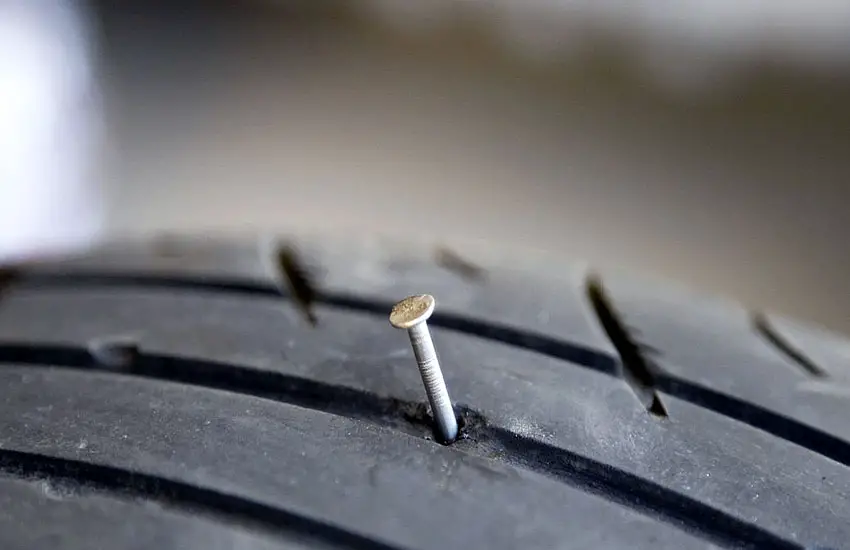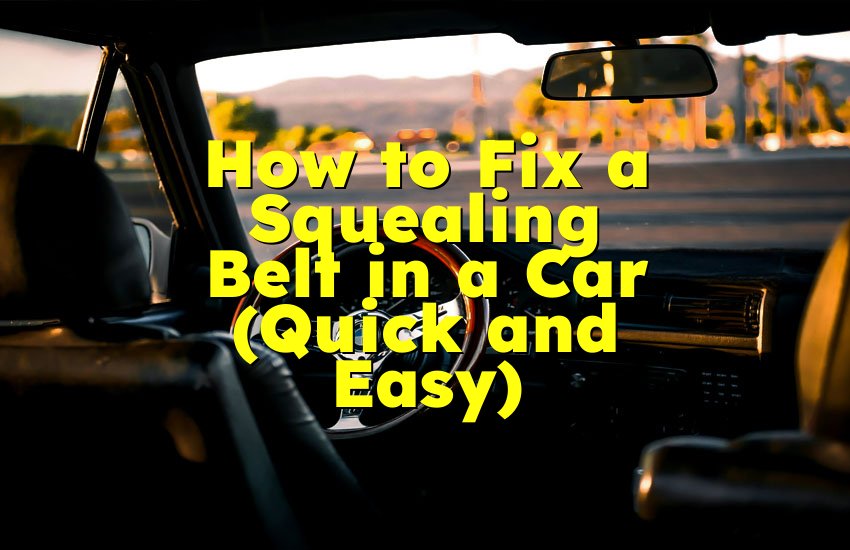As an Amazon Associate, I earn from qualifying purchases at no extra cost to you.
Nail In My Tire But Not Flat: What to Do and Why It’s Important
Have you ever found a nail in your tire, but surprisingly, it's not flat? It can be a bit of a confusing situation. Don't worry, though! If you're wondering what steps to take or whether it's safe to drive, this guide has got you covered. I'll walk you through everything you need to know, so you can feel confident handling the issue. Let's dive in!

What Does it Mean When You Find a Nail in Your Tire, But It's Not Flat?
Finding a nail in your tire is a situation no one wants to face, but it's not always as serious as it might seem. You may notice the nail lodged in your tire, yet your car is still holding air and driving just fine. This may leave you scratching your head, wondering how that's even possible.
First, let's talk about how tires work. Tires are made of layers, including rubber, steel, and fabric. The outer layer, which is made of rubber, provides the traction needed for gripping the road. Beneath that, there are steel belts and sometimes even fabric layers to reinforce the tire’s structure. If the nail punctures the outer rubber layer but doesn't reach the inner layers, it might not cause an immediate loss of air pressure.
The reason your tire isn't flat even with a nail lodged in it is usually because of one of the following:
- The Nail Isn't Deep Enough: Sometimes, a nail doesn't penetrate deeply enough into the tire to cause a significant air leak. It could be lodged in the tread or just in the outer rubber, and not all the way through to the inner parts of the tire.
- The Nail Is Plugging the Hole: If the nail is partially or fully blocking the puncture site, air can't escape as easily. The nail essentially acts as a temporary plug, slowing down or even stopping the air leak.
- The Damage Is Minimal: The nail might have caused only a minor puncture that's not enough to let air escape quickly. Sometimes, these small punctures can remain stable for quite some time, especially if the tire is still in good condition.
- The Tire Has a Slow Leak: It's also possible that the nail has caused a slow leak that isn't immediately noticeable. In some cases, it might take hours or even days for the air pressure to drop enough to cause concern.
While it might seem like good luck that the tire isn't flat, you shouldn't take this situation lightly. A nail in your tire can still lead to bigger problems down the road, and you'll want to address it before it turns into an emergency. Let's break down what to do next and how to prevent further damage.
Should You Continue Driving With a Nail in Your Tire?
The short answer is: it depends. If you've found a nail in your tire but it's not flat, you may be tempted to keep driving, thinking it's not urgent. However, this could be risky. Tires are your connection to the road, and even a small issue like a nail can lead to bigger problems. Here's why you should consider taking action right away:
1. A Slow Leak Could Become a Rapid One
Although your tire isn't flat right now, it could be losing air more slowly than you realize. It's possible that the nail is causing a slow, steady leak that you're not noticing immediately. Driving on an underinflated tire can lead to serious safety risks, including reduced traction, longer stopping distances, and a higher risk of a blowout. While it's not flat right now, you don't want to risk it becoming flat when you're on the road.
2. Tires are Critical for Safety
A properly inflated tire is crucial for vehicle control, handling, and braking. If the tire pressure starts to drop due to the nail puncture, it could affect your ability to handle the vehicle safely, especially during emergency maneuvers or in inclement weather conditions. Tires are designed to work optimally when they're fully inflated. A compromised tire, even slightly, can lead to problems with stability.
3. Damaging the Tire Further
If you continue driving on a tire with a nail in it, you risk further damaging the tire. The metal nail could cause additional wear, and if the tire becomes too worn out, it might be irreparable. Tires are expensive to replace, and continuing to drive with a damaged one can increase the cost of repair or replacement.
4. The Nail Might Not Stay in Place
While the nail might be staying in place now, it could shift or dislodge as you drive. If the nail moves, the hole could become larger, causing a more significant air loss or even a blowout. It's better to address the situation before things get worse.
5. Risk of Puncturing Other Parts of the Tire
If the nail doesn't penetrate deeply enough to cause a major air loss, it might still cause further damage to the tire's inner layers. A puncture in a critical area, like the sidewall or shoulder, could be much more severe and irreparable.
So, Should You Drive or Not?
If the puncture is in the tread area (and not the sidewall), and the air pressure seems to be holding steady, it might be okay to drive for a short time. However, you should get it inspected and repaired as soon as possible. Don't wait too long because the longer you wait, the more likely the problem could escalate.
It's always a good idea to have a professional take a look at it. They can determine if the tire is safe for further driving or if it requires a repair or replacement.
How to Handle a Nail in Your Tire: Steps to Take
Now that we've covered why you shouldn't ignore the situation, let's go over the steps you should take when you find a nail in your tire. I've outlined the best practices based on expert advice and personal experience.
Step 1: Assess the Situation
When you first notice the nail in your tire, the first thing to do is to check if the tire is losing air. Park your car on a flat, safe surface and inspect the tire visually. If the tire still appears inflated, use a tire pressure gauge to check the pressure. If the tire pressure is normal or only slightly low, you might be able to drive it to a shop for inspection.
Step 2: Avoid Driving Long Distances
Even if your tire seems to be holding air, it's a good idea to avoid driving long distances. If you must drive, keep your speed low and avoid sharp turns or sudden stops that could cause the nail to shift. Also, be mindful of tire pressure changes while driving. If you notice any significant drop in pressure while driving, pull over immediately and assess the situation.
Step 3: Get the Tire Inspected by a Professional
As soon as possible, bring your vehicle to a professional mechanic or tire shop. They can determine the extent of the damage and decide if the tire can be repaired. In many cases, if the puncture is in the tread area and is smaller than a quarter inch in diameter, the tire can be repaired. If the puncture is larger or in the sidewall, the tire may need to be replaced.
Step 4: Repair or Replace the Tire
If the tire can be repaired, the technician will likely use a plug or patch to seal the hole. If the puncture is too large, or if the tire's structural integrity has been compromised, you may need to replace the tire entirely. Some tires are eligible for a plug or patch repair if they are not too damaged, so don't assume replacement is the only option.
Step 5: Check Your Other Tires
After addressing the issue with the punctured tire, it's always a good idea to check the other tires on your vehicle. If one tire has a nail in it, the others may also show signs of wear or damage that require attention. Regularly checking tire pressure and tread depth can help you catch issues early.
I hope this helps you understand what to do when you find a nail in your tire but it's not flat. While it's not an emergency, it's still something that needs to be addressed sooner rather than later. Tires are a crucial part of your car's safety, and keeping them in good condition should be a priority. Always be cautious, get your tire inspected, and never ignore a nail in your tire, no matter how small the damage may seem.
Are These Questions in Your Mind?
Is it safe to drive with a nail in my tire?
It depends on the severity of the puncture. If your tire isn't losing air quickly, it might be safe for short distances, but you should get it repaired as soon as possible.
Can I repair a tire with a nail in it myself?
While it is possible to temporarily patch a tire with a DIY kit, it's always best to have a professional handle the repair to ensure it's done properly and safely.
Do I need to replace my tire if there's a nail in it?
If the puncture is in the tread and small, a repair may be sufficient. However, if the nail is in the sidewall or the tire is severely damaged, it may need to be replaced.
Is it expensive to repair a tire with a nail in it?
Tire repairs are usually relatively affordable, especially if the puncture is small and in the tread. The cost can range from $10 to $30, depending on the shop.
Can a nail in the tire cause a blowout?
If left unchecked, a nail in your tire could lead to a slow air leak or even a blowout, especially if it shifts or causes further damage.
Is it dangerous to drive with a slow leak from a nail?
Yes, a slow leak can reduce tire performance and increase the risk of a blowout or poor handling. It's safer to get the tire repaired promptly.
Can I use tire sealant to fix the nail in my tire?
Tire sealants can offer a temporary fix, but they are not a permanent solution. It's better to get a proper repair as soon as you can.
Is it okay to drive with a nail in the tire if the pressure is normal?
While it might be okay for a short drive, you should get the tire inspected immediately to prevent further damage and to ensure your safety.
Can a tire with a nail be patched multiple times?
Repeated patching can weaken the tire, so it's not ideal to patch the same spot multiple times. If the tire is already repaired once, it may need replacement if it gets damaged again.
Do I need to replace my tire if the nail is in the sidewall?
Yes, nails in the sidewall typically make the tire unrepairable. It's best to replace the tire to ensure your safety.











